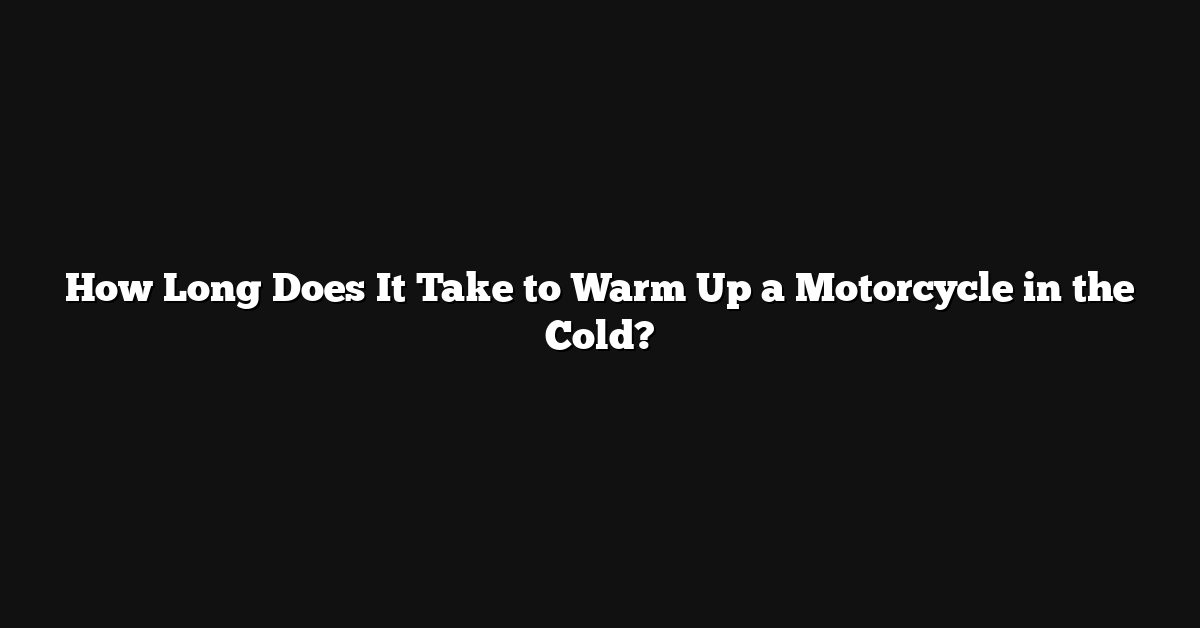As a motorcycle enthusiast, one of the most common questions I get asked is how long it takes to warm up a motorcycle in the cold. It’s a valid question, especially for those of us who live in colder climates.
The truth is, there isn’t a one-size-fits-all answer to this question. The amount of time it takes to warm up a motorcycle in the cold depends on a variety of factors.
First and foremost, the type of motorcycle you have plays a big role in how long it takes to warm up. Older carbureted motorcycles tend to take longer to warm up than newer fuel-injected models.
The size of your engine and the type of oil you use can also affect how long it takes to warm up. In general, smaller engines and thicker oils take longer to warm up than larger engines and thinner oils.
The Motorcycle Warm-Up
I know that warming up your bike before riding is important.
But why is it important and how long does it take to warm up a motorcycle in the cold? In this section, I will explore the importance of warming up your bike and the factors that affect warm-up time.
Importance of Warming Up
Warming up your motorcycle before riding is important for several reasons. One of the main reasons is to ensure that the engine is properly lubricated.
When your bike is cold, the oil is thicker and doesn’t flow as easily, which can cause unnecessary wear and tear on your engine.
By allowing your bike to warm up, the oil becomes thinner and flows more easily, ensuring that all the moving parts are properly lubricated.
Another reason to warm up your motorcycle is to ensure that the carburetor is properly adjusted.
When your bike is cold, the carburetor may not be providing the right amount of fuel to the engine, which can cause it to run poorly.
By allowing your bike to warm up, the carburetor can adjust to the proper fuel-to-air ratio, ensuring that your bike runs smoothly.
Factors Affecting Warm-Up Time
The amount of time it takes to warm up your motorcycle can vary depending on several factors. One of the main factors is the outside temperature.
The colder the temperature, the longer it will take for your bike to warm up. In extremely cold temperatures, it can take up to 10 minutes or more for your bike to warm up properly.
Another factor that affects warm-up time is the size of your engine. Larger engines take longer to warm up than smaller engines because there is more metal to heat up.
Additionally, the type of oil you use can also affect warm-up time. Thicker oils take longer to warm up than thinner oils, so if you live in a colder climate, you may want to consider using a thinner oil to help your bike warm up faster.
Warming up your motorcycle is an important step to ensure that your bike runs smoothly and lasts for years to come.
The amount of time it takes to warm up your bike can vary depending on several factors, but by understanding the importance of warming up and the factors that affect warm-up time, you can ensure that your bike is properly warmed up before hitting the road.
Practical Warm-Up Tips

Also I know how important it is to properly warm up your bike before hitting the road, especially in cold weather. Here are some practical tips to help you get your motorcycle warmed up quickly and safely.
Step-by-Step Warm-Up Process
- Turn on the ignition and let the bike idle for a few minutes. This will allow the engine oil to start flowing and warm up.
- While the engine is idling, put on your helmet, gloves, and other protective gear. This will give the engine some extra time to warm up before you start riding.
- After a few minutes of idling, rev the engine a few times to get it moving and help warm up the internal parts.
- Once the engine is warmed up, take the bike for a short ride at a slow speed. This will help warm up the tires and other components that need to be warmed up before you start riding at higher speeds.
- After the short ride, let the bike idle for another minute or two before turning it off.
Cold Weather Considerations
When riding in cold weather, there are a few additional things to keep in mind to ensure your motorcycle is properly warmed up:
- Use a battery tender to keep your battery charged and ready to go in cold weather.
- Use a synthetic oil that is designed for cold-weather riding. This will help the engine start and run smoothly in colder temperatures.
- Consider using a heated seat or grips to keep your hands and body warm while riding in cold weather.
- Be extra careful when riding in cold weather, as the roads may be icy or slippery. Take your time and ride at a slower speed until you are confident the roads are safe.
By following these practical tips, you can ensure that your motorcycle is properly warmed up and ready to go, even in cold weather.
Frequently Asked Questions

What’s the best way to warm up a carbureted motorcycle?
When warming up a carbureted motorcycle, the best way is to start the engine and let it idle for a few minutes. You can also rev the engine a few times to get the oil flowing before taking off.
How many minutes should I let my Harley Davidson idle before riding?
The amount of time you should let your Harley Davidson idle before riding depends on the temperature outside. In general, it is recommended that you let your motorcycle idle for at least 30 seconds to a minute before riding.
What’s the proper way to start a motorcycle when the engine is cold?
When starting a motorcycle with a cold engine, make sure the choke is engaged and turn the key to start the engine. Once the engine is running, let it idle for a few minutes before taking off.
Can I speed up the warm-up process for my motorcycle?
Yes, you can speed up the warm-up process for your motorcycle by revving the engine a few times. This will help get the oil flowing and warm up the engine faster.
At what temperature is it considered too cold to operate a motorcycle safely?
The temperature at which it is considered too cold to operate a motorcycle safely varies depending on the rider’s experience and the type of motorcycle. However, it is generally recommended that you avoid riding in temperatures below freezing (32°F or 0°C) to prevent the risk of ice formation on the road.

